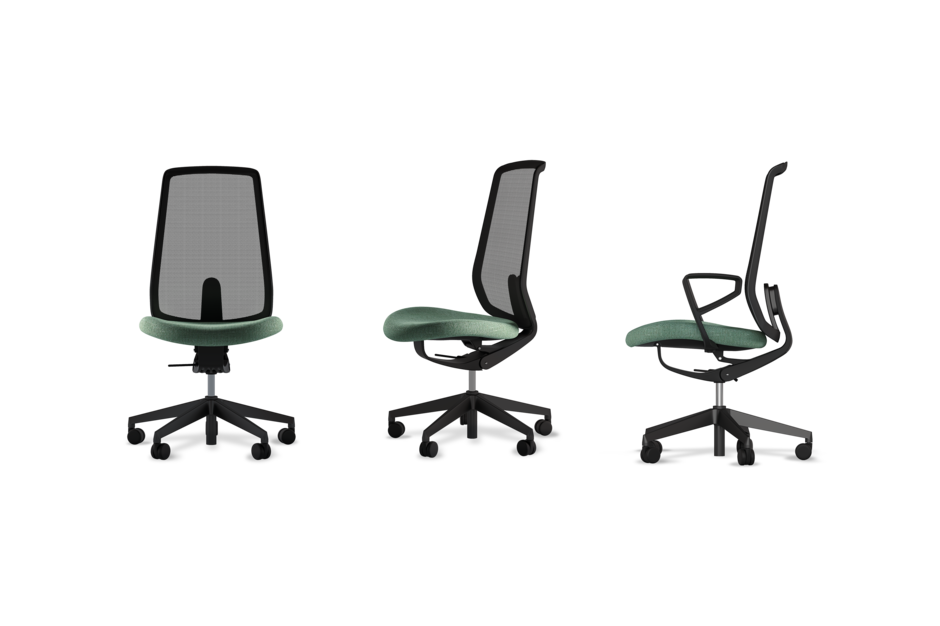motiv: Seating with a smile
Les sièges tournants apportent une contribution significative à l’ergonomie. Dans le passé, de nombreuses normes et réglementations établissaient les standards ergonomiques. On avait à disposition une foule de possibilités de réglage individuelles. Des options qui très souvent étaient mal, ou pas du tout, exploitées. Avec motiv Wiesner-Hager a développé un siège de bureau avec détection automatique du poids, qui s’aligne sur les situations de travail changeantes de l’utilisateur. Le siège met l’accent sur les fondamentales exigences ergonomiques : le soutien de l’appareil locomoteur, le soulagement des disques intervertébraux et la stimulation du système cardiovasculaire grâce à une position assise dynamique.


Un concept de design, qui mise sur un dynamisme de l‘assise et sur le confort :
Le ressort de la mécanique forme une sorte de pince avec le support du dossier, qui relie d’une façon élégante l’assise et le dossier. Tandis que le profil extérieur du cadre pour la maille tendue est très dynamique, l’assise promet un grand confort au niveau de l’optique et de la qualité tactile. « Mon intention était de provoquer l’envie de s’asseoir dans le siège. Le confort ne devrait pas seulement être amélioré par le rembourrage généreux, mais également par le fort rayon horizontal », résume le designer Andreas Krob le concept du design de motiv.
Design: Andreas Krob
A new approach to ergonomics: the twist-balance mechanism.
The twist-balance mechanism of motiv exploits the advantages of a synchronous mechanism and dispenses with the complexity of conventional mechanisms. It makes it possible to detect weight automatically with very few, but all the more flexible components by allowing the kinetic forces of the materials to take effect. A pre-tensioned spring made of high-strength polymer plastic reacts to the user's body weight when they sit down: the more weight the spring is subjected to, the greater the resistance. This automatically regulates the pressure on the backrest, thereby creating an intuitive sitting experience. No fine adjustment is necessary because motiv is able to accommodate a wide range of users from 50 to 120 kilos. At the touch of a button, the backrest can be locked in the forwardmost position. The design of the mechanism results in an elasticity of the backrest that promotes micro-movements of the spine, thus stimulating the supply of nutrients to the intervertebral discs.
Design concept that focuses on seating dynamics and comfort:
Technically, the spring of the mechanism together with the backrest supports form a kind of clamp that elegantly connects the seat and the back. While the outer contour of the mesh frame has a very dynamic design, the seat promises a high level of comfort both visually and haptically. "I wanted to create the feeling of enjoyment when sitting in the chair. The feeling of comfort was to be intensified not only by the generous upholstery, but also by the pronounced horizontal radius. Overall, the round shape of the seat is in contrast to the rather technically straight surfaces of the mechanism, the armrests and the backrest," explains designer Andreas Krob, summarising the design concept of motiv.

motiv_s.
The compact office chair motiv_s with its low upholstered back was developed specifically for agile, temporary work settings with different users. The round shape of the seat combined with an oval upholstered back ensures high seating comfort, maximum freedom of movement and active back support – even during dynamic position changes and lateral movements. The design of motiv_s plays with charming design references from the history of swivel chairs and combines them with a state-of-the-art mechanical concept for automatic weight detection and adjustment. The compact and homely appearance also makes the chair ideal for use in the home office.